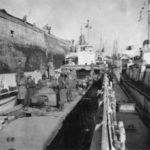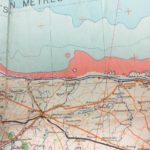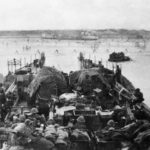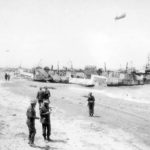Written by Geoff Woodward, Museum Manager, North & South Tyneside
Read Part 1: LCT 7074 – Hebburn’s Remarkable D-Day Survivor
At long last the mechanics seemed to have fixed the problem. The engines were running properly, and Landing Craft Tank (LCT) 7074 was ready for service. It hadn’t been an auspicious beginning for the vessel, stuck on the River Tyne for a month following construction, fit-out and handover to the Royal Navy. Hopefully it wasn’t a bad omen and a foretaste of more misfortune to come. As the LCT headed down the coast away from Tyneside to join the 17th LCT Flotilla assembling off Great Yarmouth no doubt the crew had mixed emotions – glad to be finally under way, yet nervous and tense for what lay ahead.
But once they’d joined the other vessels in the flotilla there was little time to think. Sub-Lieutenant Philip Stephens, second in command of LCT 7074, noted in his journal that they received two weeks of ‘feverish beaching and invasion training’; a crash course to prepare them as best as possible for the imminent Normandy landings. This training over, the LCT then sailed on to the River Orwell in Suffolk, where at Felixstowe on 2 June, ten tanks from the British 7th Armoured Division, the famous ‘Desert Rats’ were loaded on board. The tanks crews, nearly sixty men in total, crammed on board with the twelve crew members. LCT 7074 then made its way to the Solent area close to the Isle of Wight where it joined the full invasion flotilla heading for France.
Over 7000, mostly British, ships and boats of all shapes and sizes took part in Operation Neptune, the naval element of Operation Overlord, including landing craft which played a crucial role, carrying troops, tanks and supplies right onto the beaches. There were more than 800 Landing Craft (Tank) (LCT) vessels, like LCT 7074. The seas were rough with a heavy swell and many men were badly seasick on the journey.
On board LCT 7074 the tank crews tried to sleep squeezed into any spaces they could find beside their vehicles on the deck. They were scheduled to land in support of the 50th (Northumbria) Division on the Jig Green sector of Gold beach, in the middle of the Normandy assault beaches, late on the night of 6 June.
As the LCT approached the beach the men on board witnessed the aftermath of the initial landings. The Germans had put up a determined resistance. 25,000 troops landed on Gold beach on 6 June. 413 men were killed or wounded on the beach and 89 landing craft were destroyed that day. In the darkness those on board LCT 7074 would have glimpsed a grim scene of carnage, with wrecked boats and vehicles, the wounded and dead. The weather was still bad and the seas rough and the mass of craft and vehicles packed around the narrowed beach at high tide made landing too dangerous. LCT 7074 pulled back from the beach and withdrew out to sea to wait to return the next morning. It seemed as if the bad luck experienced with the engine problems back on Tyneside had struck again.
After another night of snatched sleep LCT 7074’s crew motored back into the Jig Green sector of Gold beach, opposite the village of Asnelles-sur-Mer, this time successfully landing, at 09.30 on 7 June. Philip Stephens described what happened:
‘Down went the ramp and out drove our tanks into six feet of water. Only one came to grief, stalling on the sea bed with the waves breaking over it, until a ‘Duck’ (amphibious vehicle) arrived to rescue the half-drowned crew. No sooner had the tanks got clear than the heavy seas and strong tide swept us and two craft together, and we proceeded to chew each other to pieces.’
LCT 7074 was stuck in the sand and had to wait all day for the tide before it could float free from the beach. The third frustrating delay that the crew had experienced! Fortunately, the fighting had moved inland, but as the crew waited, they had time to reflect on the evidence of the earlier battle on the beach. Stephens noted:
‘The craft alongside was a wreck, having received three direct hits as she went in. In a pool left by the receding tide, beside an underwater steel obstruction loaded with live mines, there floated the body of a soldier – mute witness to the battle that had raged to secure the beachhead.’
But the delay also presented a happier opportunity:
‘…some of the crew went ashore to Asnelles-sur-Mer and were toasted in champagne in the village restaurant.’
Meanwhile the tanks from the 22nd Armoured Brigade of the 7th Armoured Division carried by the LCT headed off into the battles for Normandy. They were six Stuart light tanks from the Reconnaissance Troop of the 5th Royal Tank Regiment (the seventh had been lost on landing), two unarmed Sherman ‘Observation Post’ tanks of the 5th Royal Horse Artillery (a self-propelled artillery regiment) and one Cromwell tank of the 22nd Armoured Brigade HQ. Once ashore the tanks drove inland towards Bayeux to support infantry operations clearing enemy troops from around the town. They then headed toward Tilly-sur-Seulles, before entering the town of Villers-Bocage. Here one of the unarmed ‘Observation Post’ Sherman tanks commanded by Major Denis Wells was caught up in a German attack led by German ace Michael Wittman. Wittman’s Tiger tank fired at and destroyed the Sherman. Wells and his driver, Charles Rae, were both injured as they abandoned the vehicle, but the Gunner, Leonard Norman, was killed. Six days earlier the tank and crew had been aboard LCT 7074.
Before LCT 7074 left Gold beach 200 enemy prisoners of war were loaded aboard for transportation back to England. However, since the crew did not have the means to guard the prisoners, they were transferred to a Landing Ship Tank (LST) instead. With high tide LCT 7074 was able to float off the beach on 8 June, but any celebrations were short-lived as the curse of engine trouble returned and the luckless vessel lost its convoy and arrived alone at Southampton on 9 June.
On 12 June, the day after the Normandy beachhead was fully secured, LCT 7074 was back in action bringing American paratroopers to the ‘Sugar Red’ sector of the Utah beach landings on the Cherbourg peninsula. The vessel then made 32 round trips ferrying troops and vehicles and supplies, across the English Channel to support the Allies’ military advance across France and the Low Countries. It also played a role in supplying equipment for the strategically important crossing of the River Rhine in March 1945 which enabled the troops to drive deep into Germany.
LCT 7074 was then moved up to Liverpool where it was converted into an emergency repair ship for use in the Pacific War against the Japanese, and the ship’s designation was changed to NSC L (19). However, the Japanese were defeated before it could be used in its new role, and the vessel’s wartime service was over.
As we commemorate the 75th anniversary of the Victory in Europe and reflect on what made that victory possible, D-Day stands as a critical point in the chain of events. The uncovering of the story of LCT 7074, helped by members of the Jarrow & Hebburn Local History Society and other volunteers and museum staff around the country, presents us with a compelling insight into a detail within the vast canvas of the battle. This, together with the saving, restoration and imminent display of LCT 7074 at the D-Day Story museum, connects us back to this momentous period in our history.
With thanks to:
- Jarrow & Hebburn Local History Society
- Tyne & Wear Archives
- The D-Day Story, Portsmouth
- Arts Council England
- National Lottery Heritage Fund
- National Heritage Memorial Fund
- South Tyneside Council
- Portsmouth City Council
- National Museum of the Royal Navy (NMRN)
- Sub-Lieutenant Philip Stephens, deputy of LCT 7074. © National Museum of the Royal Navy
- Sub-Lieutenant John Baggott RNVR, who commanded LCT 7074. © National Museum of the Royal Navy
- 7th Armoured Division tanks on board an LCT at Felixstowe, prior to heading for Normandy. © The D-Day Story, Portsmouth
- This close-up of a section of the 1943 Edition War Office map of Cherbourg and the area of the D-Day beaches in Normandy shows the location of Gold beach. LCT 7074 landed its tanks between Arromanches les Bains and La Rivière. The map belonged to Lieutenant Peter Saward of the Royal Engineers, who was involved in the D-Day landings. Loaned by Geoff Woodward
- LCT(4) 574 approaching Juno Beach, which was just east of Gold Beach where LCT 7074 landed. © The D-Day Story, Portsmouth
- LCT 1507 wrecked on Sword Beach, the beach at the eastern end of the D-Day landings. © The D-Day Story, Portsmouth
- LCTs and other vessels crushed in together on Gold Beach following the initial landings. © The D-Day Story, Portsmouth






